

Compact Muon Solenoid
LHC, CERN
| CMS-PAS-SUS-17-008 | ||
| Search for resonant production of second generation sleptons with same-sign dimuon events in proton-proton collisions at √s= 13 TeV | ||
| CMS Collaboration | ||
| June 2018 | ||
| Abstract: A search for resonant production of second generation sleptons (˜μ, ˜νμ) via the R-parity-violating coupling λ′211, in events with two same-sign muons and at least two jets in the final state is presented. While one muon is expected to be produced directly in the slepton decay, the second muon and at least two jets are produced in the subsequent decay of a neutralino or chargino originating from the resonant slepton. The analysis is based on the 2016 dataset of proton-proton collisions at √s= 13 TeV recorded with the CMS detector at the CERN LHC, which corresponds to an integrated luminosity of 35.9 fb−1. No significant deviation is observed with respect to standard model expectations. Upper cross section limits are derived in the context of two simplified models representing the dominant signal contributions. The cross section limits are translated into coupling limits for a modified constrained minimal supersymmetric model with λ′211 as an additional R-parity-violating coupling. The results impose significantly extended restrictions of the parameter space compared to previous searches for similar models. | ||
|
Links:
CDS record (PDF) ;
inSPIRE record ;
CADI line (restricted) ;
These preliminary results are superseded in this paper, EPJC 79 (2019) 305. The superseded preliminary plots can be found here. |
||
| Figures | |

png pdf |
Figure 1:
Dominant signal contributions in a modified cMSSM with λ′211 as an additional coupling. The left and middle diagrams are simulated as simplified models and considered as signal models for this search. |
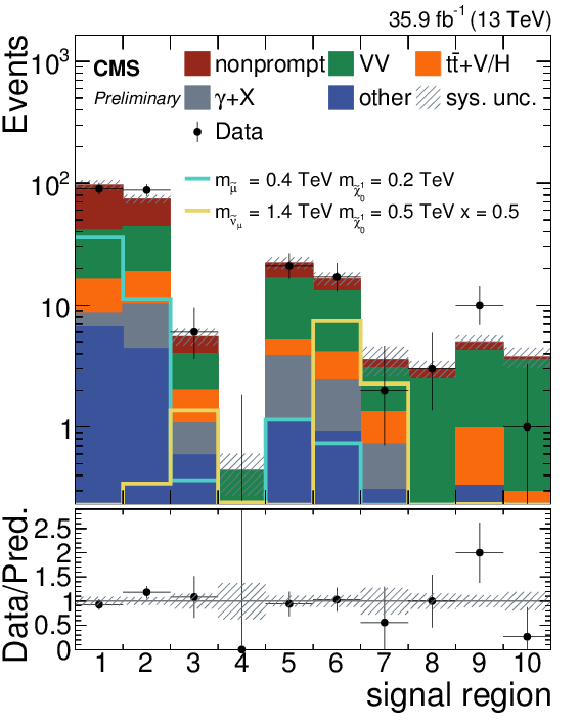
png pdf |
Figure 2:
Expected (after fit) and observed event yields in the signal regions as defined in Table xxxxx. The grey band shows the systematic uncertainty on the background yields. Also shown are the expected yields for two signal points normalized to their smallest excluded cross section. |
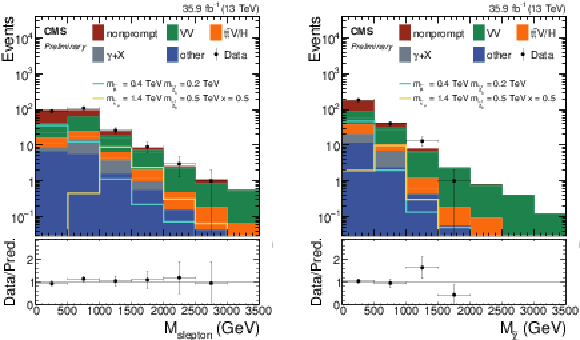
png pdf |
Figure 3:
Expected (after fit) and observed event yields in the Mslepton and M˜χ distribution. Also shown are the expected yields for two signal points normalized to their smallest excluded cross section. |
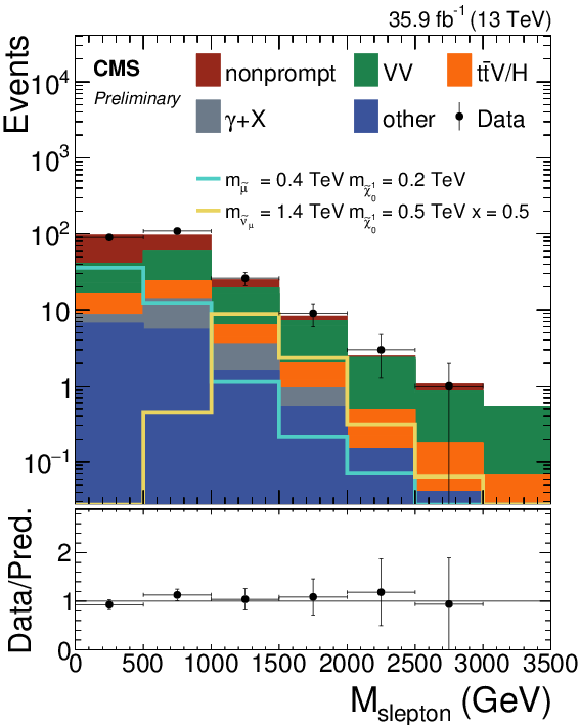
png pdf |
Figure 3-a:
Expected (after fit) and observed event yields in the Mslepton and M˜χ distribution. Also shown are the expected yields for two signal points normalized to their smallest excluded cross section. |
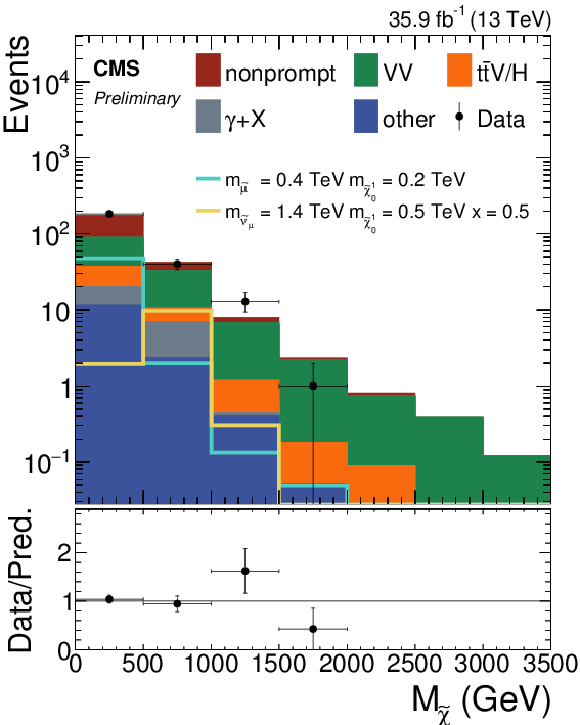
png pdf |
Figure 3-b:
Expected (after fit) and observed event yields in the Mslepton and M˜χ distribution. Also shown are the expected yields for two signal points normalized to their smallest excluded cross section. |
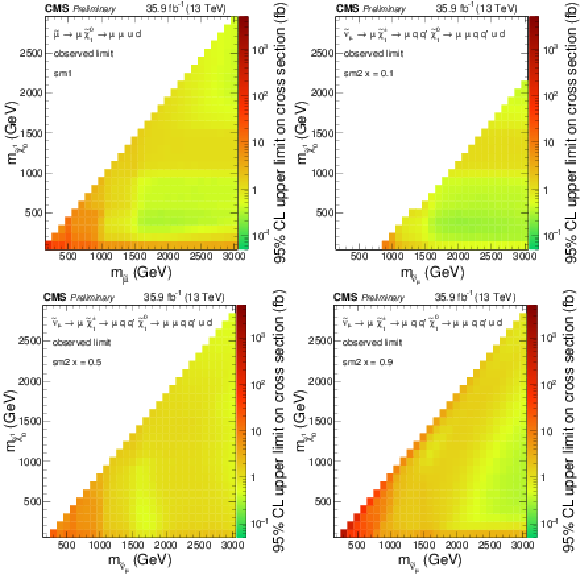
png pdf |
Figure 4:
Observed upper cross section limits at 95% CL in the mass plane given by m˜χ01 and m˜μ or m˜ν for sm1 or sm2, respectively. The limit for a specific mass combination is depicted according to the color scale on the right-hand side of the figures. |
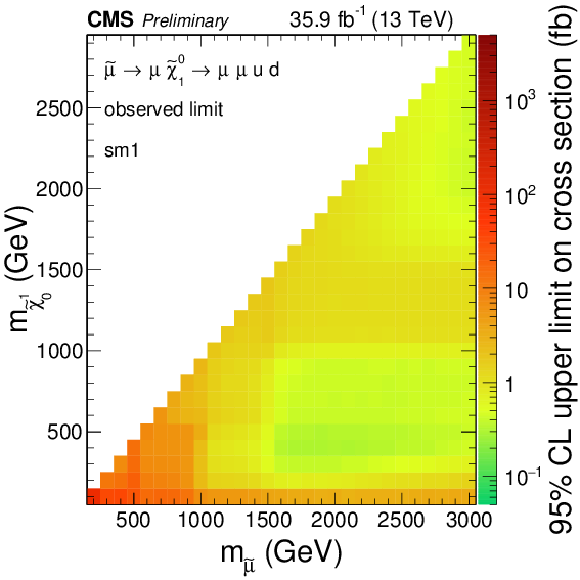
png pdf |
Figure 4-a:
Observed upper cross section limits at 95% CL in the mass plane given by m˜χ01 and m˜μ or m˜ν for sm1 or sm2, respectively. The limit for a specific mass combination is depicted according to the color scale on the right-hand side of the figures. |
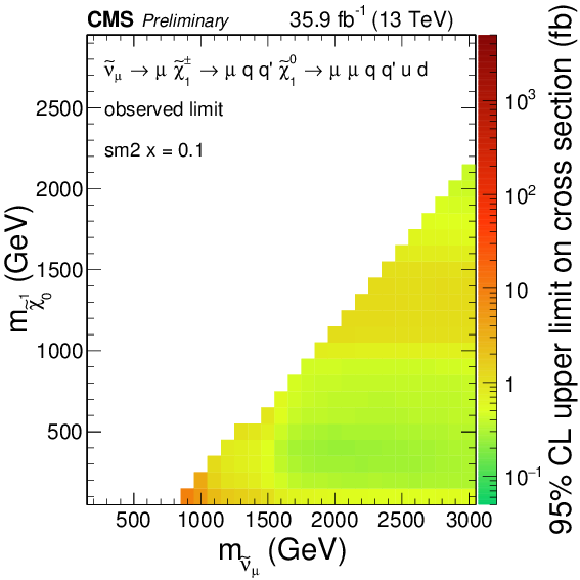
png pdf |
Figure 4-b:
Observed upper cross section limits at 95% CL in the mass plane given by m˜χ01 and m˜μ or m˜ν for sm1 or sm2, respectively. The limit for a specific mass combination is depicted according to the color scale on the right-hand side of the figures. |
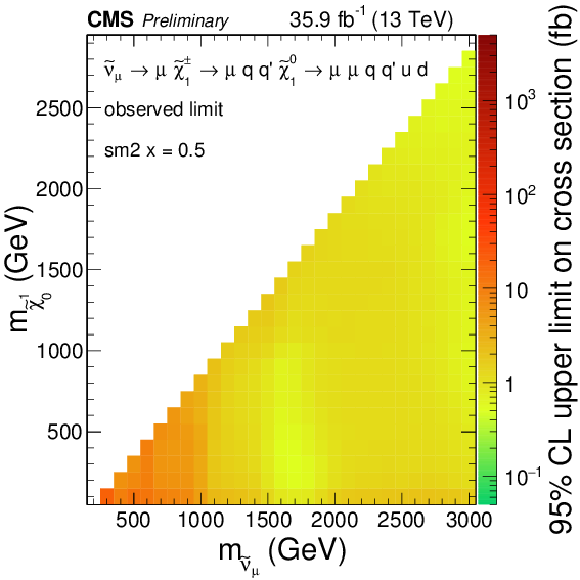
png pdf |
Figure 4-c:
Observed upper cross section limits at 95% CL in the mass plane given by m˜χ01 and m˜μ or m˜ν for sm1 or sm2, respectively. The limit for a specific mass combination is depicted according to the color scale on the right-hand side of the figures. |
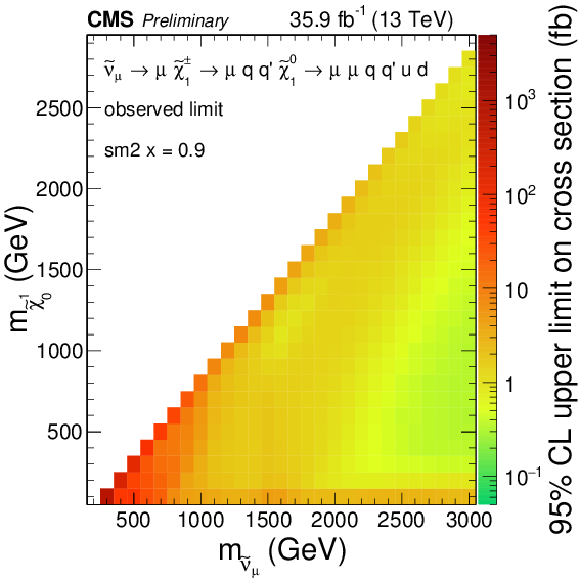
png pdf |
Figure 4-d:
Observed upper cross section limits at 95% CL in the mass plane given by m˜χ01 and m˜μ or m˜ν for sm1 or sm2, respectively. The limit for a specific mass combination is depicted according to the color scale on the right-hand side of the figures. |
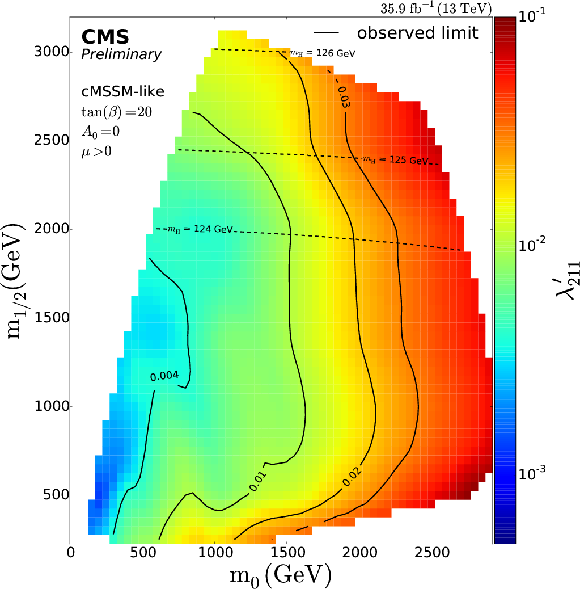
png pdf |
Figure 5:
Upper coupling limits as a function of m0 and m1/2 for a modified cMSSM with λ′211 as additional RPV coupling. The color scale at the right side of the figure indicates the coupling limit value for specific parameter combinations. These limits are derived from the upper cross section limits of sm1. For four λ′211 values (0.004, 0.01, 0.02, 0.03), the coupling limits are shown as black contour line. |
| Tables | |
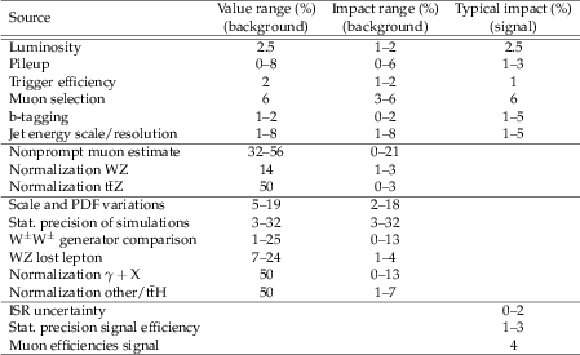
png pdf |
Table 1:
Sources of systematic uncertainties considered in this search and their values and impact ranges in the different signal regions. The background values are given with respect to the processes they concern, while the impacts are normalized to the total event yield in each signal region. For the signal, typical values for the most relevant signal regions are given. The first three blocks affect the backgrounds predictions and list all experimental uncertainties, uncertainties for processes where the yield is obtained from data, and additional uncertainties for simulation based backgrounds. For signal, the first and the last block are relevant. |
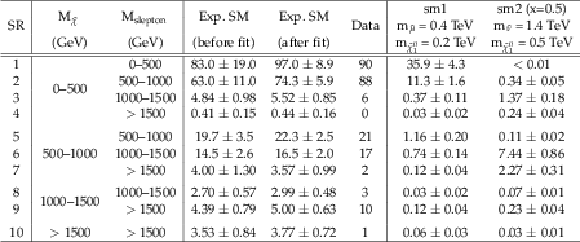
png pdf |
Table 2:
Expected and observed event yields in the signal regions. The uncertainties are the total systematic uncertainties on the expected yields. Also shown are the expected yields for two signal points normalized to their smallest excludable cross-section. |

png pdf |
Table 3:
Observed upper coupling limits for the full cMSSM-like model with λ′211 as additional coupling based on sm2 points. The masses and upper limits on the cross sections at 95% CL for the corresponding points are also shown. |
| Summary |
| A search for resonant production of second generation sleptons (˜μ, ˜νμ) with 35.9 fb−1 of proton-proton collisions recorded in 2016 with the CMS detector has been presented. The search targets resonant slepton production via the RPV coupling λ′211 in final states with two same-sign muons and at least two jets in the final state. No significant excess over the background expectation is observed. Upper cross section limits are set in the context of two simplified models covering the dominant production mechanisms in a modified constrained minimal supersymmetric model with λ′211 as additional coupling. These exclusion limits are translated into λ′211 coupling limits. The results represent the most stringent limits on this particular model of RPV SUSY. |
| References | ||||
| 1 | H. P. Nilles | Supersymmetry, Supergravity and Particle Physics | PR 110 (1984) 1 | |
| 2 | H. E. Haber and G. L. Kane | The Search for Supersymmetry: Probing Physics Beyond the Standard Model | PR 117 (1985) 75 | |
| 3 | S. P. Martin | A Supersymmetry primer | Adv. Ser. Direct. High Energy Phys. 21 (2010) 1 | hep-ph/9709356 |
| 4 | L. E. Ib\'a\ nez and G. Ross | Discrete gauge symmetries and the origin of baryon and lepton number conservation in supersymmetric versions of the standard model | NPB 368 (1992) 3 | |
| 5 | H. K. Dreiner, C. Luhn, and M. Thormeier | What is the discrete gauge symmetry of the MSSM? | PRD 73 (2006) 075007 | hep-ph/0512163 |
| 6 | G. L. Kane, C. Kolda, L. Roszkowski, and J. D. Wells | Study of constrained minimal supersymmetry | PRD 49 (1994) 6173 | |
| 7 | D0 Collaboration | Search for resonant second generation slepton production at the Tevatron | PRL 97 (2006) 111801 | hep-ex/0605010 |
| 8 | CMS Collaboration | The CMS experiment at the CERN LHC | JINST 3 (2008) S08004 | CMS-00-001 |
| 9 | CMS Collaboration | The CMS trigger system | JINST 12 (2017) P01020 | CMS-TRG-12-001 1609.02366 |
| 10 | CMS Collaboration | Particle-flow reconstruction and global event description with the CMS detector | JINST 12 (2017) P10003 | CMS-PRF-14-001 1706.04965 |
| 11 | M. Cacciari, G. P. Salam, and G. Soyez | The anti-kt jet clustering algorithm | JHEP 04 (2008) 063 | 0802.1189 |
| 12 | M. Cacciari, G. P. Salam, and G. Soyez | FastJet user manual | EPJC 72 (2012) 1896 | 1111.6097 |
| 13 | CMS Collaboration | Jet energy scale and resolution in the CMS experiment in pp collisions at 8 TeV | JINST 12 (2017) P02014 | CMS-JME-13-004 1607.03663 |
| 14 | CMS Collaboration | Identification of heavy-flavour jets with the CMS detector in pp collisions at 13 TeV | JINST 13 (2018) P05011 | CMS-BTV-16-002 1712.07158 |
| 15 | CMS Collaboration | Performance of CMS muon reconstruction in pp collision events at √s= 7 TeV | JINST 7 (2012) P10002 | CMS-MUO-10-004 1206.4071 |
| 16 | J. Alwall et al. | The automated computation of tree-level and next-to-leading order differential cross sections, and their matching to parton shower simulations | JHEP 07 (2014) 079 | 1405.0301 |
| 17 | J. Alwall et al. | Comparative study of various algorithms for the merging of parton showers and matrix elements in hadronic collisions | EPJC 53 (2008) 473 | 0706.2569 |
| 18 | J. Alwall, S. de Visscher, and F. Maltoni | QCD radiation in the production of heavy colored particles at the LHC | JHEP 02 (2009) 017 | 0810.5350 |
| 19 | R. Frederix and S. Frixione | Merging meets matching in MC@NLO | JHEP 12 (2012) 061 | 1209.6215 |
| 20 | P. Nason | A New method for combining NLO QCD with shower Monte Carlo algorithms | JHEP 11 (2004) 040 | hep-ph/0409146 |
| 21 | S. Frixione, P. Nason, and C. Oleari | Matching NLO QCD computations with Parton Shower simulations: the POWHEG method | JHEP 11 (2007) 070 | 0709.2092 |
| 22 | S. Alioli, P. Nason, C. Oleari, and E. Re | A general framework for implementing NLO calculations in shower Monte Carlo programs: the POWHEG BOX | JHEP 06 (2010) 043 | 1002.2581 |
| 23 | T. Melia, P. Nason, R. Rontsch, and G. Zanderighi | W+W−, WZ and ZZ production in the POWHEG BOX | JHEP 11 (2011) 078 | 1107.5051 |
| 24 | P. Nason and G. Zanderighi | W+W−, WZ and ZZ production in the POWHEG-BOX-V2 | EPJC 74 (2014) 2702 | 1311.1365 |
| 25 | H. B. Hartanto, B. Jager, L. Reina, and D. Wackeroth | Higgs boson production in association with top quarks in the POWHEG BOX | PRD 91 (2015) 094003 | 1501.04498 |
| 26 | E. Bagnaschi, G. Degrassi, P. Slavich, and A. Vicini | Higgs production via gluon fusion in the POWHEG approach in the SM and in the MSSM | JHEP 02 (2012) 088 | 1111.2854 |
| 27 | T. Sjostrand, S. Mrenna, and P. Z. Skands | A brief introduction to PYTHIA 8.1 | CPC 178 (2008) 852 | 0710.3820 |
| 28 | P. Skands, S. Carrazza, and J. Rojo | Tuning PYTHIA 8.1: the Monash 2013 tune | EPJC 74 (2014) 3024 | 1404.5630 |
| 29 | CMS Collaboration | Event generator tunes obtained from underlying event and multiparton scattering measurements | EPJC 76 (2016) 155 | CMS-GEN-14-001 1512.00815 |
| 30 | NNPDF Collaboration | Parton distributions for the LHC Run II | JHEP 04 (2015) 040 | 1410.8849 |
| 31 | GEANT4 Collaboration | GEANT4---a simulation toolkit | NIMA 506 (2003) 250 | |
| 32 | S. Abdullin et al. | The fast simulation of the CMS detector at LHC | J. Phys. Conf. Ser. 331 (2011) 032049 | |
| 33 | F. Staub | SARAH 4 : A tool for (not only SUSY) model builders | CPC 185 (2014) 1773 | 1309.7223 |
| 34 | F. Staub, T. Ohl, W. Porod, and C. Speckner | A Tool Box for Implementing Supersymmetric Models | CPC 183 (2012) 2165 | 1109.5147 |
| 35 | M. D. Goodsell, K. Nickel, and F. Staub | Two-Loop Higgs mass calculations in supersymmetric models beyond the MSSM with SARAH and SPheno | EPJC 75 (2015) 32 | 1411.0675 |
| 36 | F. Staub and W. Porod | Improved predictions for intermediate and heavy Supersymmetry in the MSSM and beyond | EPJC 77 (2017) 338 | 1703.03267 |
| 37 | W. Porod | SPheno, a program for calculating supersymmetric spectra, SUSY particle decays and SUSY particle production at e+ e- colliders | CPC 153 (2003) 275 | hep-ph/0301101 |
| 38 | W. Porod and F. Staub | SPheno 3.1: Extensions including flavour, CP-phases and models beyond the MSSM | CPC 183 (2012) 2458 | 1104.1573 |
| 39 | CMS Collaboration | Search for new physics in same-sign dilepton events in proton-proton collisions at √s= 13 TeV | EPJC 76 (2016) 439 | CMS-SUS-15-008 1605.03171 |
| 40 | CMS Collaboration | Reconstruction and identification of τ lepton decays to hadrons and ντ at CMS | JINST 11 (2016) P01019 | CMS-TAU-14-001 1510.07488 |
| 41 | CMS Collaboration | Search for physics beyond the standard model in events with two leptons of same sign, missing transverse momentum, and jets in proton-proton collisions at √s= 13 TeV | EPJC 77 (2017) 578 | CMS-SUS-16-035 1704.07323 |
| 42 | CMS Collaboration | CMS Luminosity Measurements for the 2016 Data Taking Period | CMS-PAS-LUM-17-001 | CMS-PAS-LUM-17-001 |
| 43 | R. D. Cousins, K. E. Hymes, and J. Tucker | Frequentist evaluation of intervals estimated for a binomial parameter and for the ratio of poisson means | NIMA 612 (2010) 388 | |
| 44 | CMS Collaboration | Search for top-squark pair production in the single-lepton final state in pp collisions at √s= 8 TeV | EPJC 73 (2013) 2677 | CMS-SUS-13-011 1308.1586 |
| 45 | T. Junk | Confidence level computation for combining searches with small statistics | NIMA 434 (1999) 435 | hep-ex/9902006 |
| 46 | A. L. Read | Presentation of search results: The CLs technique | JPG 28 (2002) 2693 | |
| 47 | G. Cowan, K. Cranmer, E. Gross, and O. Vitells | Asymptotic formulae for likelihood-based tests of new physics | EPJC 71 (2011) 1554 | 1007.1727 |
| 48 | ATLAS and CMS Collaborations | Procedure for the LHC Higgs boson search combination in summer 2011 | CMS-NOTE-2011-005 | |

|
Compact Muon Solenoid LHC, CERN |

|

|

|

|

|

|